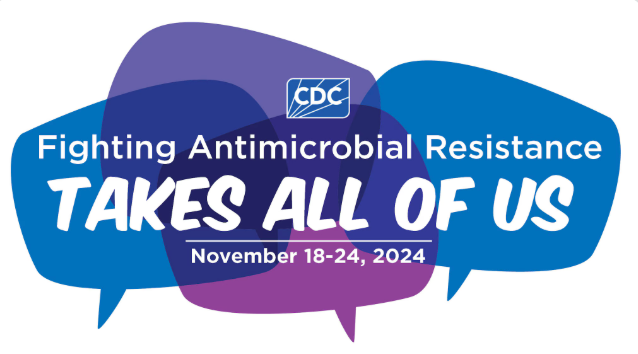U.S. Antibiotic Awareness Week (USAAW) logo
Image credits: Unsplash

November 18-24 marks US Antibiotic Awareness Week (USAAW), a critical time dedicated to raising awareness about antimicrobial resistance (AMR) and promoting responsible antibiotic and antifungal use. Led by the CDC, this annual initiative highlights AMR as a global health crisis that threatens lives worldwide.
This year’s theme, “Fighting Antimicrobial Resistance Takes All of Us,” emphasizes the need for a collective, collaborative approach to AMR. It stresses the interconnectedness of human, animal, plant, and environmental health, a concept known as the One Health approach. This framework acknowledges that the health of people, animals, and ecosystems are inextricably linked, and coordinated action is essential to address AMR.
The Growing Threat of AMR
AMR occurs when bacteria, fungi, and other pathogens evolve to resist the drugs designed to kill them. This leads to infections that are harder to treat, resulting in prolonged illness, higher healthcare costs, and in some cases, death. According to the CDC, AMR contributes to over 1.27 million deaths globally each year, with nearly 35,000 deaths in the US alone. The spread of resistant pathogens across healthcare settings, communities, and the food supply further exacerbates this public health challenge.
AMR’s global impact underscores the need for better surveillance, education, and prevention. The One Health approach is essential in addressing AMR’s widespread nature, recognizing how resistant organisms can spread across human, animal, and environmental sectors, and how collaboration across these areas is necessary to curb its spread.
The One Health Approach: A Unified Effort
The CDC’s One Health approach encompasses people, animals, plants, and their shared environment. It is essential for surveillance and response strategies, particularly in tracking pathogens like H5N1, a strain of avian influenza. By integrating expertise across disciplines, the One Health approach fosters more effective and sustainable solutions to AMR.2
Meghan Davis, DVM, PhD, MPH, a strong advocate for the One Health approach, explains that this model is crucial in understanding zoonotic diseases; diseases that can be transmitted between animals and humans. For example, the avian influenza virus, which predominantly affects birds, has demonstrated how diseases can cross between species and lead to severe health outcomes in both animals and humans.2
“As seen with avian influenza, some bird species, like waterfowl, can carry the virus without showing signs of illness, while others, such as domestic poultry, can become severely ill and die,” said Davis. “Understanding these dynamics helps us anticipate and manage the spread of infectious diseases and antimicrobial resistance.”2
Infection Prevention and Innovation: New Tools in the Fight Against AMR
What You Need To Know
AM) is a growing global health crisis that contributes to over 1.27 million deaths worldwide each year, underscoring the urgent need for effective prevention and treatment strategies.
The One Health approach, which recognizes the interconnectedness of human, animal, plant, and environmental health, is essential for effectively addressing the spread of AMR across sectors.
Innovative technologies like ActivePure, which use advanced photohydrolysis to neutralize harmful bacteria, offer promising solutions for reducing hospital-acquired infections and combating antimicrobial-resistant pathogens.
Preventing infections and reducing unnecessary use of antibiotics are key strategies in the battle against AMR. Infection control measures, such as clean water access, vaccines, and quality healthcare, play a vital role in curbing the spread of resistant pathogens. Furthermore, innovative technologies are emerging to enhance infection prevention in healthcare settings.3
ActivePure Technology, which uses advanced photohydrolysis (AP) to reduce hospital-acquired infections (HAIs), has shown promise in combating antimicrobial-resistant pathogens. The technology works continuously to neutralize harmful bacteria, including those resistant to antibiotics, without requiring additional staffing. According to Deborah Birx, MD, and Amy Carenza, BBA, from ActivePure, the technology’s ability to reduce infection rates and recovery times could revolutionize infection control in hospitals.3
“We believe that AP technology is a breakthrough,” Birx said. “It has the potential to significantly reduce AMR pathogen transmission, improve patient outcomes, and ease the strain on healthcare systems.”3
Carenza further emphasizes the importance of studying its effectiveness against multidrug-resistant organisms (MDROs), such as those responsible for central line-associated bloodstream infections (CLABSI) and catheter-associated urinary tract infections (CAUTI). Ongoing research aims to provide deeper insights into how AP can address these high-risk infections.3
A Unified Effort Against AMR
The fight against antimicrobial resistance requires a concerted, global effort. Everyone has a role to play in combatting this urgent health crisis, from healthcare providers and researchers to policymakers and the public. USAAW serves as an important platform for raising awareness and sharing knowledge on how to prevent AMR.









ch0nkk